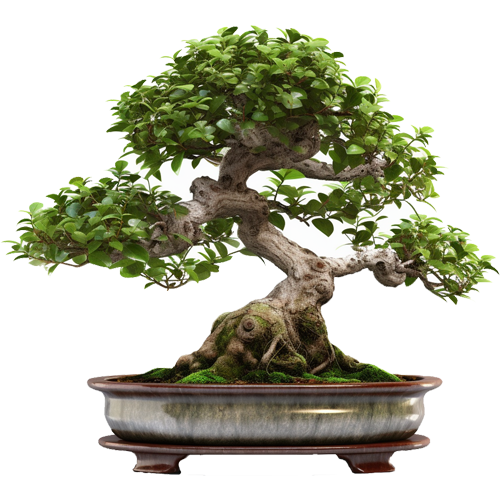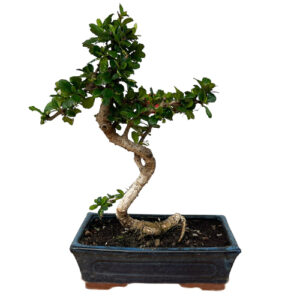Carmona Retusa
Fukien Tea Tree Bonsai
The Fukien tea tree is a subtropical species that gets its name from Fukien in China but it is native to a wide part of southeast Asia. It is an elegant species with small, dark green and glossy leaves and produces tiny white star-shaped flowers all year round. It occasionally can produce small black berries too.

Fukien Tea Tree Bonsai Care Tips
Placement
The Fukien tea tree is an indoor bonsai and can only be kept outside in warm temperatures. They require full sunlight so choose a place it where it will receive the most light such as a south-facing windowsill. It thrives in warm climates around 20 °C, and this sort of temperature should be more or less constant throughout the year. Avoid placing next to central heating sources such as radiators as this will dry out the root ball. It can survive outside in the summer if the nights are warm enough. The tea tree is a little trickier in the winter when days are shorter and colder, so consider supplementing with artificial grow lights and horticultural heaters to provide adequate energy for healthy growth.
Watering
There is no definitive guide to watering, and it should be conducted on an observational schedule, not a routine. This means that it is important to keep an eye on the moisture levels of the soil to avoid over and under watering, both which can lead to dropping leaves and/or root death. The amount of water a bonsai requires depends on pot size, climate, airflow, soil and tree type so it is best to use your eyes and fingers to assess whether the soil is damp, wet or dry.
If the top inch or so of soil has dried, it is ready to be watered. When you water, try to get an even coverage over the roots and soil, allowing water to flow out from the bottom of the pot to ensure a good soaking.
If you are a first-time bonsai owner, another way to water is by submerging the entire pot in water until the bubbles stop. If you choose this method, be aware that your bonsai may not need watering for another two to four days, but this will depend on the factors mentioned above such as soil type, pot size and climate. The Fukien tea tree dislikes short periods of drought.
The tea tree also benefits from higher humidity levels. This can be achieved by using a mister to spray the leaves, as well as placing a gravel tray under the pot to create a more humid microclimate around the tree.
Feeding & Fertilising
Using fertiliser on your tea tree will help encourage healthy growth and this should be done periodically from once a week to every two months and only during the growing season. You can start adding Chrysal Liquid Bonsai Feed to your water from March until October and use weekly. Use Naruko Fertiliser Slow Release Bonsai Feed once every one to two months. With Buddhist Pine trees, less is more, and we tend to advise using half the recommended dosage to see how your Buddhist Pine reacts first.
Pruning & Wiring
Pruning your bonsai is important not only to maintain or create an aesthetic style but to also ensure light and airflow can reach inner foliage and the tea tree handles regular trimming very well and will grow dense branch structures as a result. To prune, simply cut back shoots that have grown more than five leaves back to two.
Training your bonsai using wiring is possible with a Fukien tea tree, and the young shoots are very pliable and easy to bend. Take more care with the older branches as they are slightly more brittle and should be manipulated gently. It is recommended to not leave the wires on longer than three consecutive months to avoid biting into the delicate bark and causing scarring. When wiring, remember to choose wires with a thickness that matches the thickness of the branch: if the wire you choose is too thick you will damage the bark. If it is too thin, it won’t be effective.
Repotting
Repotting your tree is an important way to provide a fresh and suitable soil mix and ensure appropriate root health. Repot in spring. Generally, your tea tree will need to be re-potted once every two years if it is young, while older ones can stay in their pots for longer. You can do this by lifting the tree gently out of the pot by the main trunk and examining the root system. You will know it is ready if you can see the roots are circling around each other and the pot. If, however, they still appear contained in the soil, you should place it back and wait until the following spring to check again.
Trees that are ready for repotting will require root pruning, a suitable new pot and appropriate soil mix.
When repotting, do not cut back the root mass by a large amount, and choose a well-draining soil mix that has a neutral or slightly higher PH value of 5-6 but not over 7. We tend to use a mixture of different speciality bonsai soils on our trees. Every species is different so please contact us for free soil-mix advice or to take advantage of our repotting service.
Bonsai make for a one-of-a-kind indoor plant offering elegance, nature and art all in one minute form. Across an array of exquisite and erudite species, they all demand their own specific care and cultivation needs in order for their beauty to flourish. We have an extensive library of care guides for indoor bonsai trees so you can make an informed and considered choice. It’s not about selecting the perfect bonsai, it’s about selecting the perfect bonsai for you.
Fukien Tea Tree Bonsai - Typical Queries
How to propagate a Fukien Tea Tree bonsai?
To propagate a Fukien Tea bonsai, you can use seeds, cuttings, or air layering. Seeds can be sown in moist soil and kept in a warm and humid place. Cuttings can be taken from healthy shoots and planted in a pot with rooting hormone. Air layering can be done by making a cut on a branch, wrapping it with moist sphagnum moss and plastic, and cutting it off when roots appear.
How to deal with pests and diseases on a Fukien Tea Tree bonsai?
To deal with pests and diseases on a Fukien Tea Tree bonsai, you need to inspect your tree regularly and take preventive measures. Some common pests that can affect your tree are spider mites, scale insects, mealybugs, and aphids. You can use a soft brush, a cotton swab, or a spray of water to remove them. You can also use insecticidal soap or neem oil to treat them. Some common diseases that can affect your tree are root rot, leaf spot, and fungal infections. You can prevent them by keeping your tree healthy, avoiding overwatering, and providing good air circulation. You can also use fungicides to treat them.
How to style a Fukien Tea Tree bonsai?
To style a Fukien Tea Tree bonsai, you can choose from various bonsai styles, such as formal upright, informal upright, slanting, cascade, broom, forest, or literati. You can also create your own style based on your preference and creativity. You can use wiring, pruning, and shaping techniques to achieve the desired look. You can also choose a suitable pot, soil, and accessories to complement your tree.
How much sunlight does a Fukien Tea Tree bonsai need?
A Fukien Tea Tree bonsai needs a lot of natural light to thrive, but not direct sunlight. It prefers a bright location near a window, where it can receive at least four to six hours of indirect sunlight per day. If the sunlight is too strong, it can scorch the leaves and flowers. If the sunlight is too weak, it can cause the leaves to drop and the flowers to fade. You can use a curtain, a shade cloth, or a plant lamp to adjust the light intensity and duration.
Is Fukien Tea Tree bonsai indoor or outdoor?
Fukien Tea Tree bonsai can be grown both indoors and outdoors, depending on the climate and the season. It is a tropical plant that likes warmth and humidity, so it is ideal for indoor bonsai in most regions. It can tolerate temperatures between 60°F and 85°F (15°C and 30°C), but it cannot survive frost or freezing. If you live in a very warm climate, you can place your Fukien Tea Tree bonsai outside during the summer months, as long as the nights are warm enough. You can also bring it inside during the winter months, when the temperature drops below 60°F (15°C).
Why is my Fukien Tea Tree bonsai drooping?
There are several possible reasons why your Fukien Tea Tree bonsai is drooping, such as:
- Underwatering: If the soil is too dry, the leaves will wilt and droop. You need to water your tree more often and check the soil moisture regularly.
- Overwatering: If the soil is too wet, the roots will rot and the leaves will turn yellow and droop. You need to water your tree less often and improve the soil drainage.
- Pest infestation: If the leaves are covered with tiny webs, spots, or scales, your tree may have spider mites, scale insects, mealybugs, or aphids. You need to remove the pests with a soft brush, a cotton swab, or a spray of water. You can also use insecticidal soap or neem oil to treat them.
- Disease infection: If the leaves have brown or black spots, patches, or edges, your tree may have leaf spot, fungal infection, or root rot. You need to prune the affected leaves and branches and apply fungicide to treat them. You also need to keep your tree healthy, avoid overwatering, and provide good air circulation.









